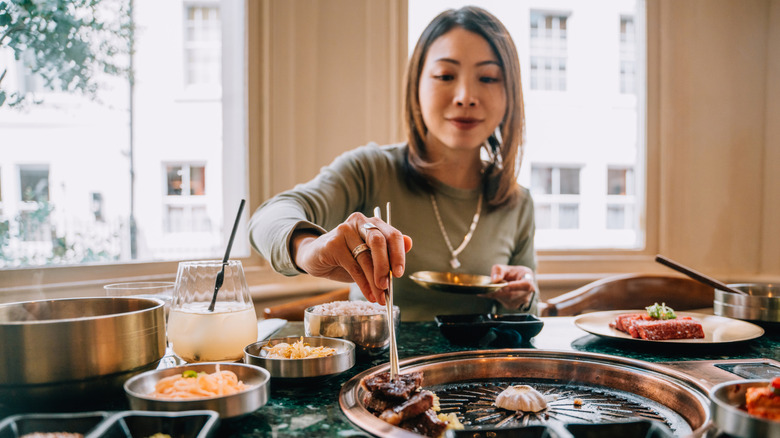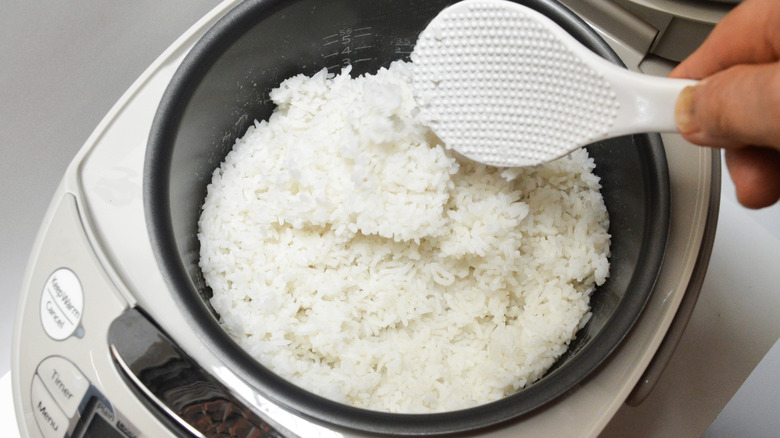The Appliance You Need To Host Korean BBQ From Your Dining Room Table
We may receive a commission on purchases made from links.
Korean BBQ is one of the most fun restaurant experiences out there — everyone gathering around a fancy grill to eat mountains of meat, rice, and kimchi is just the peak of communal dining. The side dishes are great too, with my personal favorite being dakgangjeong (otherwise known as the best chicken wings on Earth). However, Korean BBQ doesn't have to be restricted to dining out — you can also do it from the comfort of your own home. All you need is a portable grill to sit in the middle of your table.
While Korean BBQ at a restaurant is often cooked over charcoal, gas or electric grills are the go-to tools for home cooking. Getting the grill out for a home BBQ is a common weekend activity in both Korea and Japan, and it's perfect for an impromptu gathering since all you need to do is grab the ingredients and turn on the grill. Pre-marinated meats might be harder to come by in the west, however, so you might have to do that part in advance.
One of the best things about Korean BBQ is that it gives everyone the freedom to eat whatever they want: your favorite vegetables and cuts of meat, and seasoning prepared to whatever spice level you like most. Some people opt for gochujang-loaded pork with some serious heat, while others prefer sweet and sticky bulgogi beef. When combined with short-grain rice and a big bowl of kimchi, it really is the ultimate meal.
Everything you need to know about at-home grills
There are two main types of portable grills: gas (propane) and electric. You can buy either type — it's really just down to preference. Some people like a bit of fire to add char to their food and better mimic the restaurant experience, while others prefer to avoid the smoke and open flames. Many grills (like this electric model and this propane model) also have interchangeable plates, so you can grill meat in different ways. Some even come with a plate for takoyaki (octopus pancake balls). Using a portable grill is pretty easy; all you have to do is set it in the middle of your table, turn it on, and wait for it to heat up.
Now that you've locked down the grill, the next decision to make is: what to cook? Meat is one of the most common ingredients in Korean BBQ; it can be marinated or unmarinated, with common cuts including pork belly, pork neck, pork jowl, and thinly sliced cuts of beef. Vegetables are also a staple: Bean sprouts, carrots, cucumber, and green onions are all frequently used in Korean BBQ. Some people also like to use big leaves of lettuce to make ssam wraps.
Korean BBQ restaurants also offer a lot of side dishes, but it's fine to keep things simple at home. The main star is always kimchi, but there are also other jangajji, or pickled vegetable dishes. Korean BBQ is also all about dipping sauces, including ssamjang, seasoned sesame oil, and gochujang-based sauces.
Top tips for your first at-home Korean BBQ
If you're not careful, Korean BBQ can be an extremely messy affair. To make the cleanup process easier, there are a few precautions you can take.
First, open the windows and turn on your extraction fan — especially if you're using a propane grill. Restaurants have extractor fans set up right above the grill to limit smoke, but you'll be sitting quite a distance from yours, so opening the windows as well will help to keep the room clear. No one wants to sit coughing while they eat!
Second, a classic "mom trick" in Japan when families have their version of at-home BBQ is to cover the table and surrounding floor with newspaper or other absorbent material. Oil and fat have a surprisingly wide splatter radius, and this will save you from having to mop afterward. With everyone grabbing and grilling their own food, there's also likely to be a lot of drops and spills, especially if you're eating with kids.
Grilling meat as you go means it's always piping hot as you eat, so you'll want piping hot rice to accompany it. A good tip is to make a large batch of rice in the rice cooker (an Instant Pot works really well, too) and leave it on "keep warm," so people can take small portions and keep going back for more. For the most part, however, Korean BBQ is all about freedom — so try out whatever ideas you want and have fun.


